How To Draw Out Wooden Gears
How to make wooden gears
This page as well available in Spanish
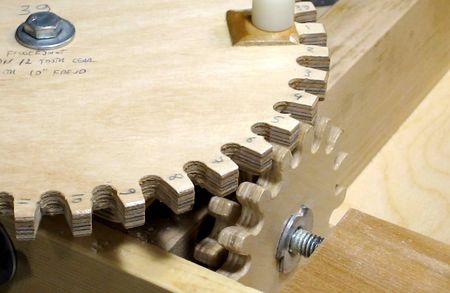
Many woodworkers are intimidated at the prospect of making their own wooden gears for the screw advance box articulation jig. So I figured I'd cover the topic of gear making in a scrap more detail.
You tin click on whatsoever epitome in this article to get a larger view.
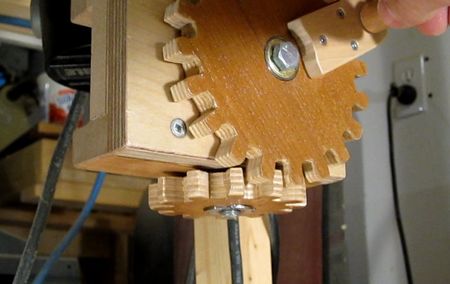
The method I use to make the gears for the box joint jig is the same as for the gears for the wooden router lift, merely I'll focus on the ones for the box joint jig in this article.
It's vital to use good plywood for the gears. Ordinary spruce or fir plywood has layers that are too coarse, and the woods is not stiff enough. But the Baltic birch plywood, with thin birch layers throughout, makes for an excellent textile. You may also take some success using UHMW plastic, Masonite or Phenolic. Only regular boards or normal plywood are not recommended.
 Start by making a template for the gear shape. There are several ways to make a gear template. Y'all can use the free online gear template generator, or my more sophisticated gear template generator, or, if y'all are using the box joint jig plans or the router lift plans, you can just print the appropriate sized templates straight from the plans. The box joint jig plans fifty-fifty include gears of every size upwardly to 48 teeth.
Start by making a template for the gear shape. There are several ways to make a gear template. Y'all can use the free online gear template generator, or my more sophisticated gear template generator, or, if y'all are using the box joint jig plans or the router lift plans, you can just print the appropriate sized templates straight from the plans. The box joint jig plans fifty-fifty include gears of every size upwardly to 48 teeth.
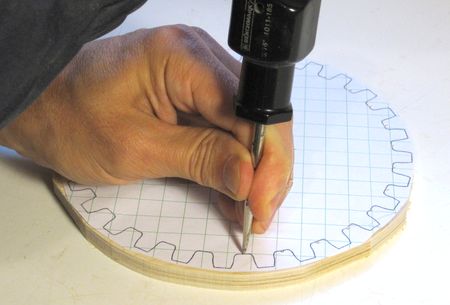 Glue the newspaper template onto a piece of birch plywood most ten mm (iii/8") thick. I ever glue it on past putting a very sparse glaze of wood glue effectually the border of the gear and so pressing the paper template on.
Glue the newspaper template onto a piece of birch plywood most ten mm (iii/8") thick. I ever glue it on past putting a very sparse glaze of wood glue effectually the border of the gear and so pressing the paper template on.
Next, use an awl to punch a divot in the center between every 2 gear teeth.
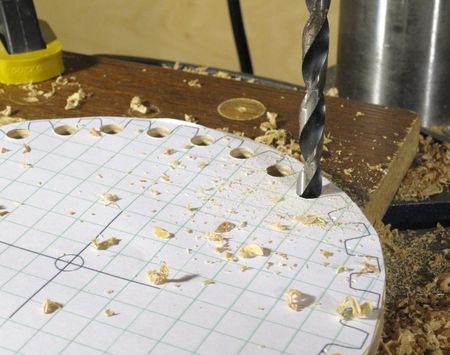 Apply a v/16 (8 mm) brad signal drill to drill out a hole in every space between the teeth. 5/16" is simply the correct size for the tooth spacing used in the gears for the box articulation jig or the router lift.
Apply a v/16 (8 mm) brad signal drill to drill out a hole in every space between the teeth. 5/16" is simply the correct size for the tooth spacing used in the gears for the box articulation jig or the router lift.
The divots made with the awl help to heart the indicate of the drill on every hole. Notation that the drill cuts a bit more abroad than the template would suggest, simply that's ok.
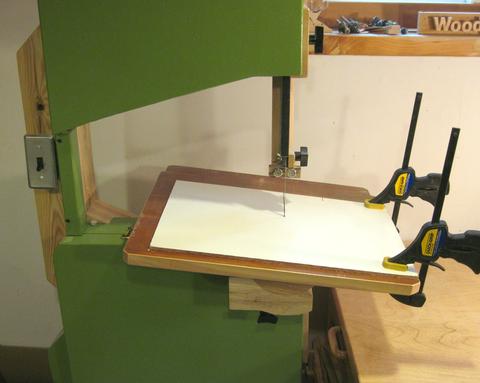 Because my gears accept to mesh at 90 degrees, it It's best to tilt the table when making the cuts on the sides of the teeth. This results in teeth that are slightly tapered towards the mating gear.
Because my gears accept to mesh at 90 degrees, it It's best to tilt the table when making the cuts on the sides of the teeth. This results in teeth that are slightly tapered towards the mating gear.
The table should be tilted to the right when cut the left sides of the teeth, and left when cutting the correct sides of the teeth, and then that the teeth will taper to be narrower towards the bottom.
I'm too using this piece of plywood clamped to the tabular array as a sort of nada clearance bandsaw insert which cuts downwardly on tearout on the bottom of the gear.
Its actually relatively easy to brand zero clearance inserts for my bandsaw, but tilitng the table with a nada clerance insert around the bract tin can be a bad idea.
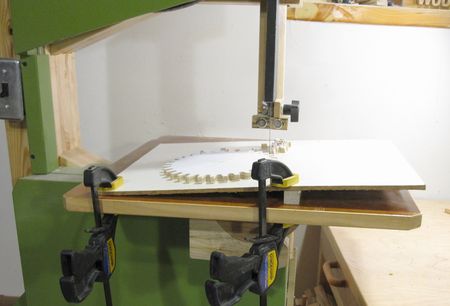 If your bandsaw table can't be tilted left (the i on my homemade bandsaw doesn't tilt left), you tin improvise by putting a piece of plywood over the and tilting information technology with a spacer.
If your bandsaw table can't be tilted left (the i on my homemade bandsaw doesn't tilt left), you tin improvise by putting a piece of plywood over the and tilting information technology with a spacer.
If you are making normal gears that mesh in the same airplane (equally opposed to gears that imperfectly mesh at ninety degrees for my jigs), you shouldn't cut the teeth at an angle, so the whole tilting the table attribute is unnecessary.
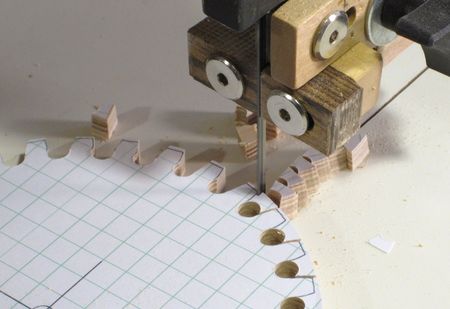 With the spaces betwixt the teeth already cut out by the holes we drilled, there's no need to cut sideways at the bottom of the teeth, so the cutting goes pretty fast. Having seen various videos of homemade CNC machines cutting gears on YouTube, I'm pretty sure I tin can cut one faster by mitt than nearly homemade CNC machines, specially because the CNC machines typically need to take ii or three passes for this thickness of material.
With the spaces betwixt the teeth already cut out by the holes we drilled, there's no need to cut sideways at the bottom of the teeth, so the cutting goes pretty fast. Having seen various videos of homemade CNC machines cutting gears on YouTube, I'm pretty sure I tin can cut one faster by mitt than nearly homemade CNC machines, specially because the CNC machines typically need to take ii or three passes for this thickness of material.
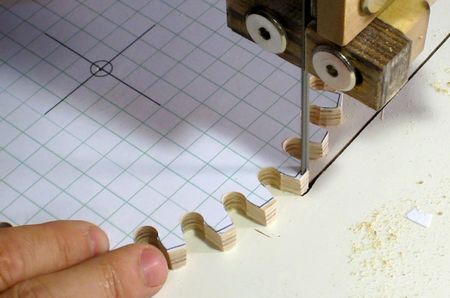 After cutting the sides of the teeth, I trim all the teeth to length.
After cutting the sides of the teeth, I trim all the teeth to length.
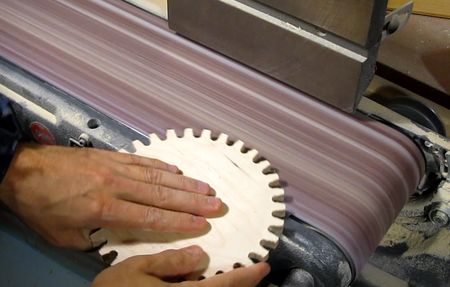 After cutting all the teeth, and drilling the eye hole, the template isn't needed anymore. I usually sand information technology off with a chugalug sander. It helps to scrape equally much as possible of it away with a chisel beginning.
After cutting all the teeth, and drilling the eye hole, the template isn't needed anymore. I usually sand information technology off with a chugalug sander. It helps to scrape equally much as possible of it away with a chisel beginning.
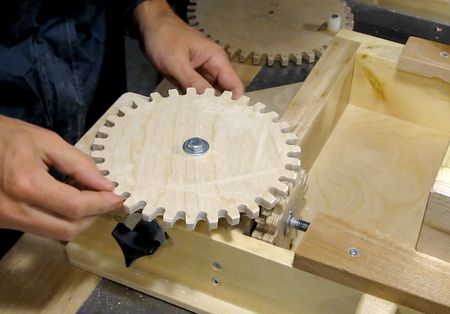 Time to endeavour out the new gear by mounting it on my box joint jig. This one worked fine, without whatever binding. If you are making your first gear, you might want to endeavor information technology out before sanding off the template, but in example you desire to look at what might exist left of the lines on the template when tweaking it a bit.
Time to endeavour out the new gear by mounting it on my box joint jig. This one worked fine, without whatever binding. If you are making your first gear, you might want to endeavor information technology out before sanding off the template, but in example you desire to look at what might exist left of the lines on the template when tweaking it a bit.
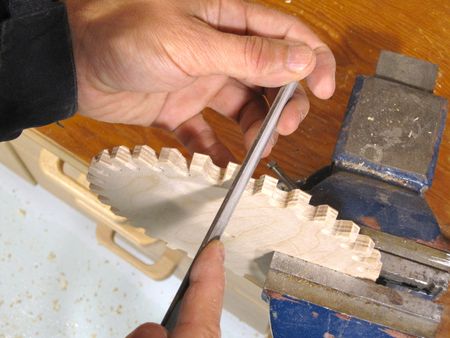 If some parts of your gear practise cease up binding, y'all can utilise a file to tweak the shape of the teeth.
If some parts of your gear practise cease up binding, y'all can utilise a file to tweak the shape of the teeth.
You can barely see how the teeth are slightly tapered towards the bottom in this pic. But that makes a big departure. I used to not taper the teeth, and they would commonly require a scrap of work with the file to go them to not bind.
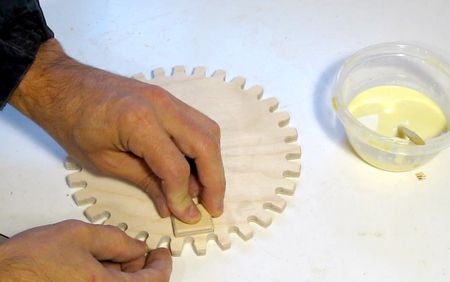 For the box joint jig gears, I demand to attach a handle to the gear. But the x mm thick birch plywood is a petty too thin for the screw to agree well, so I always end upwardly gluing a block of forest to part of the gear.
For the box joint jig gears, I demand to attach a handle to the gear. But the x mm thick birch plywood is a petty too thin for the screw to agree well, so I always end upwardly gluing a block of forest to part of the gear.
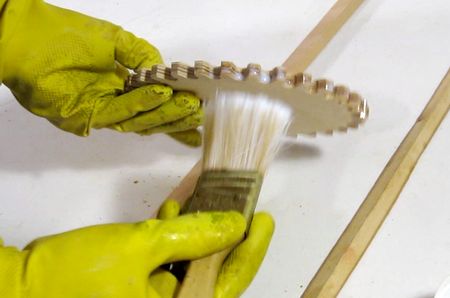 Next I apply two or three coats of varnish. I figure the varnish helps bind the fibers of the teeth together to cut down on clothing. It also helps the gear slide more than easily on the jig then it'southward easier to plow.
Next I apply two or three coats of varnish. I figure the varnish helps bind the fibers of the teeth together to cut down on clothing. It also helps the gear slide more than easily on the jig then it'southward easier to plow.
If you don't want to carp with varnish, it might exist a practiced idea to harden the teeth by brushing a bit of woods glue on the edges.
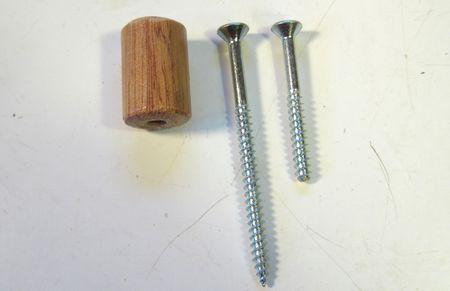 I like to use a spiral with a smooth shank for the handle. But short wood screws always accept the threads all the mode up to the caput. So I utilize a much longer wood screw instead, and I cut the screw to the right length with an angle grinder.
I like to use a spiral with a smooth shank for the handle. But short wood screws always accept the threads all the mode up to the caput. So I utilize a much longer wood screw instead, and I cut the screw to the right length with an angle grinder.
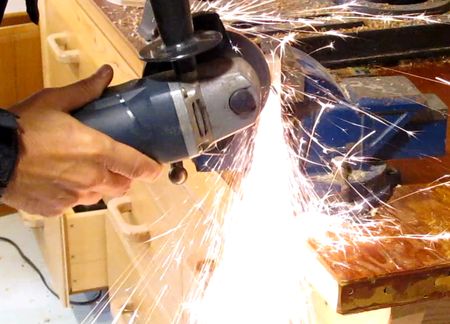 It'southward always fun to see the sparks fly. Usually there aren't this many sparks, but I deliberately cut fast to get more sparks in the picture. I cut through that spiral in well-nigh a second. Maybe a little also fast!
It'southward always fun to see the sparks fly. Usually there aren't this many sparks, but I deliberately cut fast to get more sparks in the picture. I cut through that spiral in well-nigh a second. Maybe a little also fast!
I held the spiral by screwing it into a piece of wood, and clamping that slice of woods in the vise. Y'all might exist tempted to cutting the screw off with a hack saw, but the steel in wood screws is a fiddling too difficult to cut well with a saw.
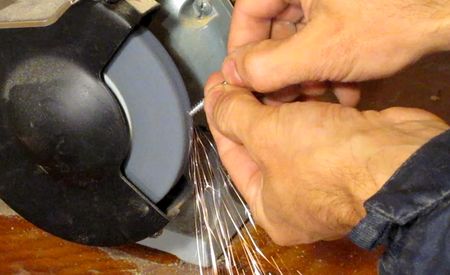 Later on cutting if off, I de-burr it and put a slight taper on the end of it so I can notwithstanding get information technology into the hole. I deliberately drill the screw pigsty on the small side, and so that the screw volition fit very tight.
Later on cutting if off, I de-burr it and put a slight taper on the end of it so I can notwithstanding get information technology into the hole. I deliberately drill the screw pigsty on the small side, and so that the screw volition fit very tight.
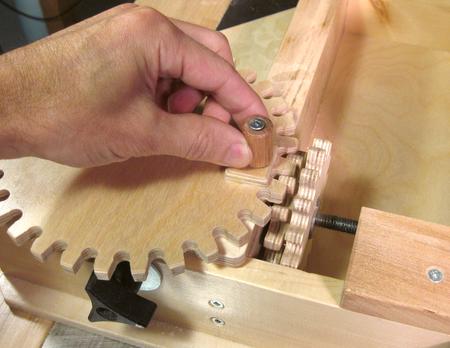 Spiral the handle screw in all the fashion, then back it out by about a quarter turn so that the handle spins freely on the screw shank. Also make certain that the screw doesn't stick out the bottom of the gear.
Spiral the handle screw in all the fashion, then back it out by about a quarter turn so that the handle spins freely on the screw shank. Also make certain that the screw doesn't stick out the bottom of the gear.
And that's all there's to it. I have made near x gears of various sizes for my box joint jig, merely you really don't need that many. Just that every time I need to infinite cuts at an interval I don't already have the correct gear for, I just brand the exact size gear for information technology.
And finally, a video of the whole procedure:
Gear related projects and tools:
Source: https://woodgears.ca/gear/howto.html
Posted by: rhodescapassicer.blogspot.com


0 Response to "How To Draw Out Wooden Gears"
Post a Comment